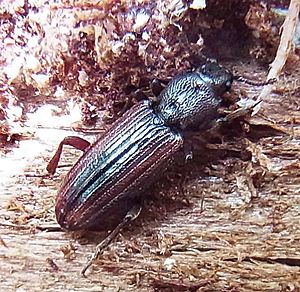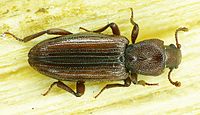Bothrideres bipunctatus
| Bothrideres bipunctatus | ||||||||||||
|---|---|---|---|---|---|---|---|---|---|---|---|---|

Bothrideres bipunctatus under pine bark |
||||||||||||
| Systematics | ||||||||||||
|
||||||||||||
| Scientific name | ||||||||||||
| Bothrideres bipunctatus | ||||||||||||
| ( Gmelin , 1790) |

|
Fig. 1: Top view |

|
Fig. 2: underside |

|
Fig. 3: Front view |
Bothrideres bipunctatus ( Syn .: Bothrideres contractus ) is a beetle from the family of the blind beetles (Bothrideridae), whichbelongsto the relatives of the flat beetles (Cucujidae). Inaddition to Bothrideres bipunctatus , the genus Bothrideres is also represented in Europeby the species Bothrideres interstitialis , whose occurrence is limited to France and Spain.
The genus name Bothrideres from ancient Gr. βόθρος "bóthros" for "pit" and δέρη "dére" for "neck" and the species name bipunctatus ( Latin "with two points") refer to the two pits in the pronotum .
In Germany's Red List of Endangered Animals, the beetle is classified under Category I (“threatened with extinction”). There it bears the name of the common gout juice beetle .
Characteristics of the beetle
The flattened beetle becomes three to five millimeters long. The entire body is dark rust-red in color and shiny.
The head lies in an extension of the body axis, the mouthparts are only slightly inclined downwards. The eleven-part antennae are string-shaped and end in a two-part club. The narrow labrum is slightly outlined in front and has strong eyelashes (Fig. 3). The broad upper jaws have three blunt teeth at the top and a narrow skin seam on the inside. The grinding surface is small. The end link of the jaw probe is elongated and pointed, the end link of the lip probe is narrowed and trimmed at the tip.
The pronotum is wider than the head and narrower than the elytra together. It is about the same length as it is wide, reaches its greatest width a little behind the front edge and narrows towards the rear. It is very coarse and tightly dotted . In the middle there is a largely unpunctured, glossy, smooth callus that ends in a pit-like depression on both sides.
The elytra have clear rows of strong points. In the latter there are very fine, inwardly lying hairs. Every other space between the rows of dots carries a loose row of less powerful dots. The shoulders are drawn forward and blunt-tooth-like to the front and inside. The wing covers widen a little up to the middle, behind that they narrow in a concave manner and end together with a rounded shape. A wide strip along the wing-cover seam and a narrower one on the outer edge of the wing-cover is more or less darkened.
The legs are of average length and strength, the tarsi are all four-limbed.
biology
The beetles live under the bark and in old wood in the boreholes of other insects living in the wood. Willows and poplars are mentioned in particular, oak and beech in the east , as well as maples , pines and fruit trees . Larvae and adults are predatory, mainly from beetle species of the genera Ips and Anobium . The adults may eat spider eggs.
There is hypermetamorphosis in the development of the larvae. After a still unknown mobile larval stage, the following relatively immobile larval stages with an enlarged abdomen live parasitically on larvae and pupae of wood-dwelling insects. Pupation takes place in a cocoon. The adults appear in Poland in May and June, the development is presumably two years.
distribution
The species is distributed discontinuously in Europe and Siberia, this jungle relic is very rare in Central Europe.
literature
- Heinz joy, Karl Wilhelm Harde, Gustav Adolf Lohse (ed.): The beetles of Central Europe . tape 7 . Clavicornia. Spektrum Akademischer Verlag, Munich 1967, ISBN 3-8274-0681-1 .
- Gustav Jäger (Ed.): CG Calwer’s Käferbuch . K. Thienemanns, Stuttgart 1876, 3rd edition
- Klaus Koch : The Beetles of Central Europe Ecology . 1st edition. tape 2 . Goecke & Evers, Krefeld 1989, ISBN 3-87263-040-7 .
Individual evidence
- ↑ Bothrideres bipunctatus in Fauna Europaea. Retrieved September 6, 2012
- ↑ Bothrideres at Fauna Europaea. Retrieved September 6, 2012
- ↑ Bothrideres interstitialis in Fauna Europaea. Retrieved September 6, 2012
- ↑ Sigmund Schenkling: Explanation of the scientific beetle names (genera)
- ↑ Sigmund Schenkling: Explanation of the scientific beetle names (species)
- ↑ Red List
- ↑ Klaus Koch : Die Käfer Mitteleuropas Ökologie . 1st edition. tape 2 . Goecke & Evers, Krefeld 1989, ISBN 3-87263-040-7 .
- ↑ a b B. Klausnitzer: Observations on the biology of Bothrideres bipunctatus (Gmelin, 1790) (Col., Bothrideridae) Entomologische Nachrichten undberichte, 49, 2005/1 pp. 71-72
- ↑ coleopterological Polish page on Art